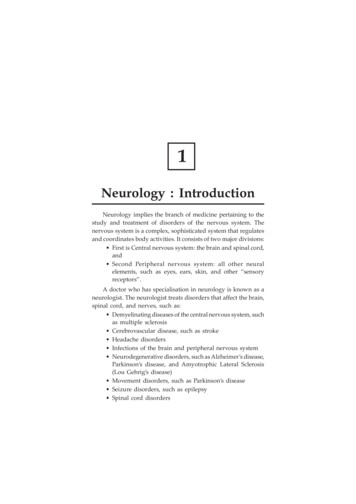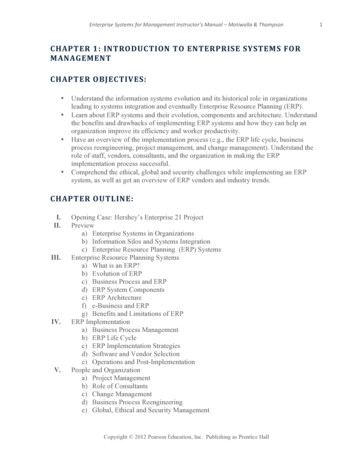
Transcription
Neurology : Introduction11Neurology : IntroductionNeurology implies the branch of medicine pertaining to thestudy and treatment of disorders of the nervous system. Thenervous system is a complex, sophisticated system that regulatesand coordinates body activities. It consists of two major divisions: First is Central nervous system: the brain and spinal cord,and Second Peripheral nervous system: all other neuralelements, such as eyes, ears, skin, and other “sensoryreceptors”.A doctor who has specialisation in neurology is known as aneurologist. The neurologist treats disorders that affect the brain,spinal cord, and nerves, such as: Demyelinating diseases of the central nervous system, suchas multiple sclerosis Cerebrovascular disease, such as stroke Headache disorders Infections of the brain and peripheral nervous system Neurodegenerative disorders, such as Alzheimer’s disease,Parkinson’s disease, and Amyotrophic Lateral Sclerosis(Lou Gehrig’s disease) Movement disorders, such as Parkinson’s disease Seizure disorders, such as epilepsy Spinal cord disorders
2Neurology Speech and language disorders.Neurologists do not perform surgery. If one of their patientsrequires surgery, they refer them to a neurosurgeon.A number of neurologists also have additional training orinterest in one area of neurology, such as stroke, epilepsy,neuromuscular, sleep medicine, pain management, or movementdisorders.WHO’S NEUROLOGISTNeurologist is a medical doctor who possesses specializedtraining in diagnosing, treating and managing disorders of thebrain and nervous system. Pediatric neurologists are doctors withspecialized training in children’s neurological disorders. Aneurologist’s educational background and medical trainingincludes an undergraduate degree, four years of medical school,a one-year internship and three years of specialized training.Many neurologists also have additional training in one areaof neurology such as stroke, epilepsy or movement disorders.Role Play by NeurologistNeurologists are principal care providers or consultants. Incomparison to other physicians a patient has a neurological disorderthat requires frequent care, a neurologist is often the principal careprovider. Patients with disorders such as Parkinson’s disease,Alzheimer’s disease or multiple sclerosis may use a neurologistas their principal care physician. In a consulting role, a neurologistwill diagnosis and treat a neurological disorder and then advisethe primary care physician managing the patient’s overall health.For instance, a neurologist would act in a consulting role forconditions such as stroke, concussion or headache. Neurologistscan recommend surgical treatment, but they do not performsurgery. When treatment includes surgery, neurologists willmonitor surgically treated patients and supervise their continuingtreatment.
Neurology : Introduction3Neurosurgeons are medical doctors who specialize inperforming surgical treatments of the brain or nervous system.Treatment by NeurologistDisorders of the nervous system, brain, spinal cord, nerves,muscles and pain are mainly treated by Neurologist. Commonneurological disorders include: StrokeAlzheimer’s diseaseHeadacheEpilepsyParkinson’s diseaseSleep disordersMultiple sclerosisPainTremorBrain and spinal cord injuriesBrain tumoursPeripheral nerve disordersAmyotrophic lateral sclerosis.
4NeurologyNew FindingsIn last few years, research has advanced understandingfundamental mechanism of the brain. With this new understanding,neurologists are finding new treatments and, ultimately, cures formany neurological diseases, which are among the most destructiveand costly public health problems in the United States. For instance,research breakthroughs now permit neurologists to successfullytreat stroke patients with clot-busting medication proven to reducedeaths and decrease disability.Research developments have also produced new medicationsthat relieve migraines, slow the progression of multiple sclerosisand improve movement in Parkinson’s patients. These are just afew of the many advances gained from research that are improvingthe lives of millions of men and women around the world sufferingfrom neurological disorders. To keep research advancing towardfuture cures and treatments, it’s significant for patients to advocatefor additional research funding. Contact your members of Congressand ask them to support neurology research.NEUROLOGICAL EXAMINATIONDuring this examination, the health history of the patient isreviewed by neurologist with special attention to the currentcondition. The patient then takes a neurological exam. Typically,the exam tests mental status, function of the cranial nerves(including vision), strength, coordination, reflexes, and sensation.This information endorse the neurologist determine whether theproblem exists in the nervous system and the clinical localization.Localization of the pathology is the key process by whichneurologists develop their differential diagnosis. Further tests maybe needed to confirm a diagnosis and ultimately guide therapyand appropriate management.Neurologists TasksIn the clinic the chief task of Neurologists is to examine patientswho have been referred to them by other physicians in both the
Neurology : Introduction5inpatient and outpatient settings. A neurologist will start theirinteraction with a patient by taking a comprehensive medicalhistory, and then perform a physical examination focusing onevaluating the nervous system. Components of the neurologicalexamination include assessment of the patient’s cognitive function,cranial nerves, motor strength, sensation, reflexes, coordination,and gait. In few examples, neurologists may order additionaldiagnostic tests as part of the evaluation. Commonly employedtests in neurology comprise imaging studies such as computedaxial tomography (CAT) scans, magnetic resonance imaging (MRI),and ultrasound of major blood vessels of the head and neck.Neurophysiologic studies, including electroencephalography(EEG), needle electromyography (EMG), nerve conduction studies(NCSs) and evoked potentials are also commonly ordered.Neurologists frequently perform lumbar punctures in orderto assess characteristics of a patient’s cerebrospinal fluid. Advancesin genetic testing has made genetic testing and important tool inthe classification of inherited neuromuscular disease.The role of genetic influences on the development of acquiredneuromuscular diseases is an active area of research.Some of the conditions commonly encountered treated byneurologists include radiculopathy, neuropathy, headaches, stroke,dementia, seizures and epilepsy, Alzheimer’s Disease, Attentiondeficit/hyperactivity disorder, Parkinson’s Disease, Tourette’ssyndrome, multiple sclerosis, head trauma, sleep disorders,neuromuscular diseases, and different types of infections andtumours of the nervous system.Neurologists are also asked to evaluate unresponsive patientson life support in order to confirm brain death. Treatment optionsvary depending on the neurological problem. They can includeeverything from referring the patient to a physiotherapist, toprescribing medications, to recommending a surgical procedure.Some neurologists specialize in certain parts of the nervoussystem or in specific procedures. For example, clinical
6Neurologyneurophysiologists specialize in the use of EEG and intraoperativemonitoring in order to diagnose certain neurological disorders.Other neurologists specialize in the use of electrodiagnosticmedicine studies - needle EMG and NCSs. In the US, physiciansdo not typically specialize in all the aspects of clinicalneurophysiology - i.e. sleep, EEG, EMG, and NCSs.The American Board of Clinical Neurophysiology certifies USphysicians in general clinical neurophysiology, epilepsy, andintraoperative monitoring. The American Board ofElectrodiagnostic Medicine certifies US physicians inelectrodiagnostic medicine and certifies technologists in nerveconduction studies. Sleep medicine is a subspecialty field in theUS under several medical specialties including anesthesiology,internal medicine, family medicine, and neurology.Neurosurgery is a distinct specialty that involves a differenttraining path, and emphasizes the surgical treatment of neurologicaldisorders. There are also many non-medical doctors, those withPhD degrees in subjects such as biology and chemistry, who studyand research the nervous system. Working in labs in universities,hospitals, and private companies, these neuroscientists performclinical and laboratory experiments and tests in order to learnmore about the nervous system and find cures or new treatmentsfor diseases and disorders.There is a great deal of overlap between neuroscience andneurology. A large number of neurologists work in academictraining hospitals, where they conduct research as neuroscientistsin addition to treating patients and teaching neurology to medicalstudents.General CaseloadNeurologists are responsible for the diagnosis, treatment, andmanagement of all the conditions mentioned above. When surgicalintervention is required, the neurologist may refer the patient toa neurosurgeon. In some countries, additional legal responsibilitiesof a neurologist may include making a finding of brain death
Neurology : Introduction7when it is suspected that a patient has died. Neurologists frequentlycare for people with hereditary (genetic) diseases when the majormanifestations are neurological, as is frequently the case.Lumbar punctures are frequently performed by neurologists.Some neurologists may develop an interest in particular subfields,such as stroke, dementia, movement disorders, neurointensivecare, headaches, epilepsy, sleep disorders, chronic painmanagement, multiple sclerosis, or neuromuscular diseases.Overlapping with other SpecialitiesOverlaping with other specialties, varying from country tocountry and even within a local geographic area is also a case.Acute head trauma is most often treated by neurosurgeons, whereassequelae of head trauma may be treated by neurologists orspecialists in rehabilitation medicine. Although traditionally strokecases have been managed by internal medicine or hospitalists, theemergence of vascular neurology and interventional neurologistshas created a demand for stroke specialists. The establishment ofJCAHO certified stroke centres has increased the role ofneurologists in stroke care in many primary as well as tertiaryhospitals. Some cases related to nervous system infectious diseasesare treated by infectious disease specialists.Most of cases related to headache are diagnosed and treatedprimarily by general practitioners, at least the less severe cases.Likewise, most cases of sciatica and other mechanicalradiculopathies are treated by general practitioners, though theymay be referred to neurologists or a surgeon (neurosurgeons ororthopedic surgeons).Pulmonologists and psychiatrists also treat sleep disorders.Cerebral palsy is initially treated by pediatricians, but care maybe transferred to an adult neurologist after the patient reaches acertain age. Physical medicine and rehabilitation physicians alsoin the US diagnosis and treat patients with neuromuscular diseasesthrough the use of electrodiagnostic studies (needle EMG andnerve conduction studies) and other diagnostic tools. In the United
8NeurologyKingdom and other countries, many of the conditions encounteredby older patients such as movement disorders includingParkinson’s Disease, stroke, dementia or gait disorders are managedpredominantly by specialists in geriatric medicine.Clinical neuropsychologists are often called upon to evaluatebrain-behaviour relationships for the purpose of assisting withdifferential diagnosis, planning rehabilitation strategies,documenting cognitive strengths and weaknesses, and measuringchange over time (e.g., for identifying abnormal aging or trackingthe progression of a dementia).Relationship to Clinical NeurophysiologyNeurologists in some countries, like USA and Germany, maysubspecialize in clinical neurophysiology, the field responsible forEEG and intraoperative monitoring, or in electrodiagnosticmedicine nerve conduction studies, EMG and evoked potentials.In other countries, this is an autonomous specialty (e.g., UnitedKingdom, Sweden, Spain).Interaction with PsychiatrySome are of the view that mental illnesses are neurologicaldisorders affecting the central nervous system, traditionally theyare classified separately, and treated by psychiatrists. In a 2002,Professor Joseph B. Martin, Dean of Harvard Medical School anda neurologist by training, wrote in an article that “the separationof the two categories is arbitrary, often influenced by beliefs ratherthan proven scientific observations. And the fact that the brainand mind are one makes the separation artificial anyway”.Neurological disorders generally have psychiatric manifestations,such as post-stroke depression, depression and dementia associatedwith Parkinson’s disease, mood and cognitive dysfunctions inAlzheimer’s disease and Huntington disease, to name a few. Hence,there is not always a great distinction between neurology andpsychiatry on a biological basis. The dominance of psychoanalytictheory in the first three quarters of the 20th century has since thenbeen largely replaced by a focus on pharmacology. Inspite of the
Neurology : Introduction9shift to a medical model, brain science has not advanced to thepoint where scientists or clinicians can point to readily discerniblepathologic lesions or genetic abnormalities that in and of themselvesserve as reliable or predictive biomarkers of a given mentaldisorder.EMERGING FIELD OF NEUROLOGICALENHANCEMENTThe rising field of neurological enhancement concentrates onthe potential of therapies to improve such things as workplaceefficacy, attention in school, and overall happiness in personallives. However, this field has also led to questions about neuroethicsand the psychopharmacology of lifestyle drugs.
10Neurology2Neuro AnatomyNeuroanatomy is the study of the structure and function ofthe nervous system. The nervous system is made up of manyconnected systems that work together to send and receive messagesfrom the central nervous system, which is the brain and spinalcord, to the rest of the body. These systems comprised the centralnervous system, peripheral nervous system, and somatic nervoussystem. They also include the autonomic nervous system,sympathetic nervous system, and parasympathetic nervous system.Within each of these systems, information is carried in electricalenergy by nerve cells and neurons.It is the brain which control our every thought and action.Brain is the most complex organ of our body. The brain is dividedinto functional units with particular function such as processingvisual information or responding to fearful experiences. Each ofthese units is made up of brain cells that work together. These cellsalso form connections with cells in other functional units, creatingcommunication routes for brain signals. Using new tools to tagand trace brain circuits, scientists are working to better understandhow the human brain is organized to perform its many functions.Ongoing studies in animals and people are helping scientistsrecognize the many different types of brain cells and the roles theyplay. In addition, imaging technology is helping map brain regionsresponsible for specific functions and behaviors.
Neuro Anatomy11The physical structure of neuroanatomy is that of the nervoussystem. The central nervous system is made up of the brain andspinal cord. The peripheral nervous system is formed by the nervesand pathways that send messages from the central nervous systemto the rest of the body.The peripheral nervous system is divided into twosubcategories: the somatic nervous system and the autonomicnervous system. The somatic nervous system is liable for carryingsensory information from the sense organs to the central nervoussystem as well as carrying motor instructions to the muscles. Theautonomic nervous system can also be further divided into twosubcategories. The sympathetic nervous system is the part of theautonomic nervous system that is responsible for fight or flightresponse, and the parasympathetic nervous system is in charge ofresting states and conserving energy.NERVOUS SYSTEMTHE NERVOUS SYSTEM considered to be the mostcomplicated and highly organized of the various systems whichmake up the human body. It is the mechanism concerned with thecorrelation and integration of various bodily processes and thereactions and adjustments of the organism to its environment. Inaddition the cerebral cortex is related to conscious life. It is dividedinto two parts, central and peripheral.The central nervous system have the encephalon orbrain,contained within the cranium, and the medulla spinalis orspinal cord,lodged in the vertebral canal; the two portions arecontinuous with one another at the level of the upper border ofthe atlas vertebra.The peripheral nervous system comprises a series of nervesby which the central nervous system is connected with the diversetissues of the body. For descriptive purposes these nerves may bearranged in two groups, cerebrospinal and sympathetic, thearrangement, however, being an arbitrary one, since the two groupsare intimately connected and closely intermingled. Both the
12Neurologycerebrospinal and sympathetic nerves have nuclei of origin (thesomatic efferent and sympathetic efferent) as well as nuclei oftermination (somatic afferent and sympathetic afferent) in thecentral nervous system.Tere are forty three cerebrospinal nerves on either side—twelve cranial, attached to the brain, and thirty-one spinal, to themedulla spinalis. They are associated with the functions of thespecial and general senses and with the voluntary movements ofthe body. The sympathetic nerves transmit the impulses whichregulate the movements of the viscera, determine the caliber ofthe bloodvessels, and control the phenomena of secretion. Relatedto them are two rows ofcentral ganglia, situated one on either sideof the middle line in front of the vertebral column; these gangliaare intimately related to the medulla spinalis and the spinal nerves,and are also joined to each other by vertical strands of nerve fibersso as to constitute a pair of knotted cords, the sympathetic trunks,which reach from the base of the skull to the coccyx. Thesympathetic nerves issuing from the ganglia form three greatprevertebral plexuses which supply the thoracic, abdominal, andpelvic viscera; in relation to the walls of these viscera intricatenerve plexuses and numerous peripheral ganglia are found.Nervous System: Its StructureGenerally nervous tissues are made of nerve cells and theirvarious processes, together with a supporting tissue calledneuroglia, which, however, is found only in the brain and medullaspinalis. Some long processes of the nerve cells are of specialsignificance, and it is convenient to consider them apart from thecells; they are known as nerve fibers. To the naked eye a differenceis obvious between certain portions of the brain and medullaspinalis, viz., the gray substance and the white substance. Thegray substance is largely composed of nerve cells, while the whitesubstance contains only their long processes, the nerve fibers.It is in the former that nervous impressions are received,stored, and transformed into efferent impulses, and by the latter
Neuro Anatomy13that they are conducted. Hence the gray substance forms theessential constituent of all the ganglionic centers, both those in theisolated ganglia and those aggregated in the brain and medullaspinalis; while the white substance forms the bulk of thecommissural portions of the nerve centers and the peripheralnerves.What is Neuroglia?Neuroglia is the peculiar ground substance in which the truenervous constituents of the brain and medulla spinalis areimbedded. It consists of cells and fibers. Some of the cells arestellate in shape, with ill-defined cell body, and their fine processesbecome neuroglia fibers, which extend radially and unbranchedamong the nerve cells and fibers which they aid in supporting.Other cells give off fibers which branch repeatedly.Some of the fibers start from the epithelial cells lining theventricles of the brain and central canal of the medulla spinalis,and pass through the nervous tissue, branching repeatedly to endin slight enlargements on the pia mater. Thus, neuroglia is evidentlya connective tissue in function but is not so in development; it isectodermal in origin, whereas all connective tissues aremesodermal.Nerve CellsIn the gray substance of the brain and medulla spinalis, butsmaller collections of these cells also form the swellings, knownas ganglia, seen on many nerves. These latter are found chieflyupon the spinal and cranial nerve roots and in connection withthe sympathetic nerves.There are different shape and size of nerve cells and have oneor more processes. They may be divided for purposes of descriptioninto three groups, according to the number of processes whichthey possess:(1) Unipolar cells are found in the spinal ganglia; the singleprocess, after a short course, divides in a T-shaped manner
14Neurology(2) Bipolar cells are also found in the spinal ganglia when thecells are in an embryonic condition. They are bestdemonstrated in the spinal ganglia of fish. Sometimes theprocesses come off from opposite poles of the cell, and thecell then assumes a spindle shape; in other cells bothprocesses emerge at the same point.In some cases where two fibers are explicity connectedwith a cell, one of the fibers is really derived from anadjoining nerve cell and is passing to end in a ramificationaround the ganglion cell, or, again, it may be coiled spirallyaround the nerve process which is issuing from the cell.(3) Multipolar cells has pyramidal or stellate shape, andcharacterized by their large size and by the numerousprocesses which issue from them. The processes are of twotypes: one of them is termed the axis-cylinder process oraxon because it becomes the axis-cylinder of a nerve fiber.The others are termed the protoplasmic processes or dendrons;they start to divide and subdivide soon after they emerge fromthe cell, and finally end in minute twigs and become lost amongthe other elements of the nervous tissue.FIG. : Different forms of nerve cells. A. Pyramidal cell. B. Smallmultipolar cell, in which the axon quickly divides into numerousbranches. C. Small fusiform cell. D and E. Ganglion cells (E showsT-shaped division of axon).ax. Axon. c. Capsule.
Neuro Anatomy15FIG. : Bipolar nerve cell from the spinal ganglion of the pike. (AfterKölliker.)Fig. : Motor nerve cell from ventral horn of medulla spinalis ofrabbit. The angular and spindle-shaped Nissl bodies are well shown.
16NeurologyThe body of the nerve cell is called cyton, have a finelyfibrillated protoplasmic material, of a reddish or yellowishbrowncolour, which occasionally presents patches of a deeper tint, causedby the aggregation of pigment granules at one side of the nucleus,as in the substantia nigra and locus cæruleus of the brain.The protoplasm also contains peculiar angular granules, whichstain deeply with basic dyes, such as methylene blue; these areknown as Nissl’s granules . They extend into the dendritic processesbut not into the axis-cylinder; the small clear area at the point ofexit of the axon in some cell types is termed the cone of origin.During fatigue or after prolonged stimulation of the nervefibers connected with the cells. They are supposed to represent astore of nervous energy, and in different types of mental diseasesare deficient or absent. The nucleus is, as a rule, a large, welldefined, spherical body, generally presenting an intranuclearnetwork, and containing a well-marked nucleolus.Fig. : Pyramidal cell from the cerebral cortex of a mouse.
Neuro Anatomy17Fig. : Cell of Purkinje from the cerebellum. Golgi method. (Cajal.)a.Axon. b. Collateral. c and d. Dendrons.Besides the protoplasmic network as has been described above,each nerve cell may be shown to have delicate neurofibrils runningthrough its substance; these fibrils are continuous with the fibrilsof the axon, and are believed to convey nerve impulses. Golgi hasalso described an extracellular network, which is probably asupporting structure.Nerve FibersIn the peripheral nerves and in the white substance of thebrain and medulla spinalis nerve fibers are found universally.They are of two kinds—viz., medullated or white fibers, and nonmedullated orgray fibers.The medullated fibers form the white part of the brain andmedulla spinalis, and also the greater part of every cranial andspinal nerve, and give to these structures their opaque, whiteaspect. When perfectly fresh they appear to be similar; but soonafter removal from the body each fiber presents, when examinedby transmitted light, a double outline or contour, as if consistingof two parts. The central portion is named the axis-cylinder; around
18Neurologythis is a sheath of fatty material, staining black with osmic acid,named the white substance of Schwann ormedullary sheath, whichgives to the fiber its double contour, and the whole is enclosedin a delicate membrane, the neurolemma, primitive sheath, ornucleated sheath of Schwann.Fig. : Nerve cells of kitten, showing neurofibrils. (Cajal.) a. Axon.b.Cyton. c. Nucleus. d. Neurofibrils.The axis-cylinder is an integral part of the nerve fiber, and isalways present; the medullary sheath and the neurolemma areoccasionally absent, especially at the origin and termination of thenerve fiber. The axis-cylinder undergoes no interruption from itsorigin in the nerve center to its peripheral termination, and mustbe considered as a direct prolongation of a nerve cell. It constitutesabout one-half or one-third of the nerve fiber, being greater inproportion in the fibers of the central organs than in those of thenerves.It is rather transparent, and is therefore indistinguishable ina perfectly fresh and natural state of the nerve. It is made up ofexceedingly fine fibrils, which stain darkly with gold chloride, andat its termination may be seen to break up into these fibrillæ. Thefibrillæ have been termed as primitive fibrillæ of Schultze.
Neuro Anatomy19The axis-cylinder is said by some to be enveloped in a specialreticular sheath, which separates it from the medullary sheath,and is composed of a substance calledneurokeratin. The morecommon opinion is that this network or reticulum is contained inthe white matter of Schwann, and by some it is believed to beproduced by the action of the reagents employed to show it.Fig. : Medullated nerve fibers. X 350.Fig. : Longitudinal sections of medullated nerve fibers. Osmic acid.
20NeurologyFig. : Transverse sections of medullated nerve fibers. Osmic acid.Fig. : Medullated nerve fibers stained with osmic acid. X 425.(Schäfer.) R. Nodes of Ranvier. a. Neurolemma. c. Nucleus.The medullary sheath, or white matter of Schwann , is a fattymatter in a fluid state, which insulates and protects the essentialpart of the nerve—the axis-cylinder. It is of diverse thickness, insome forming a layer of extreme thinness, so as to be scarcely
Neuro Anatomy21distinguishable, in others forming about one-half the nerve fiber.The variation in diameter of the nerve fibers (from 2 to 16ì) dependsmainly upon the amount of the white substance, though the axiscylinder also varies within certain limits. The medullary sheathfaces interruptions at regular intervals, giving to the fiber theappearance of constriction at these points: these are known as thenodes of Ranvier.The portion of nerve fiber between two nodes is called aninternodal segment. The neurolemma or primitive sheath is notinterrupted at the nodes, but passes over them as a continuousmembrane. If the fiber be treated with silver nitrate the reagentpenetrates the neurolemma at the nodes, and on exposure to lightreduction takes place, giving rise to the appearance of black crosses,Ranvier’s crosses, on the axis-cylinder.Beyond the nodes termed Frommann’s lines there may alsobe seen transverse lines; the significance of these is not understood.In addition to these interruptions oblique clefts may be seen in themedullary sheath, subdividing it into irregular portions, whichare termed medullary segments, or segments of Lantermann ;there is reason to believe that these clefts are artificially producedin the preparation of the specimens.Fig. : Medullated nerve fibers stained with silver nitrate.
22NeurologyFig. : A small nervous branch from the sympathetic of a mammal.a.Two medullated nerve fibers among a number of gray nervefibers, b.Medullated nerve fibers, when examined in the fresh condition,frequently present a beaded or varicose appearance: this is dueto manipulation and pressure causing the oily matter to collectinto drops, and as result of the extreme delicacy of the primitivesheath, even slight pressure will cause the transudation of thefatty matter, which collects as drops of oil outside the membrane.The neurolemma or primitive sheath is a delicate, structurelessmembrane. Here and there beneath it, and situated in depressionsin the white matter of Schwann, are nuclei surrounded by a smallamount of protoplasm. The nuclei is shape are oval and somewhatflattened, and bear a definite relation to the nodes of Ranvier, onenucleus generally lying in the center of each internode. In allmedullated nerve fibers the primitive sheath is not present, beingabsent in those fibers which are found in the brain and medullaspinalis.Wallerian DegenerationIf nerver fibres are cut across its central ends degenerate asfar as the first node of Ranvier; but the peripheral ends degenerate
Neuro Anatomy23simultaneously throughout their whole length. The axons breakup into fragments and become surrounded by drops of fat
cranial nerves, motor strength, sensation, reflexes, coordination, and gait. In few examples, neurologists may order additional diagnostic tests as part of the evaluation. Commonly employed tests in neurology comprise imaging studies such as computed axial











